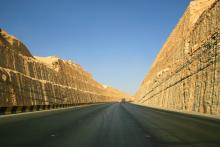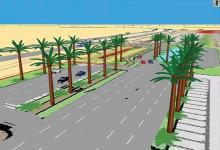Saudi Arabia is suffering from poor road safety, despite continuing investment in infrastructure. The country’s road crash rate is very high, accounting for up to 19 deaths/day on average. The data shows that Saudi Arabia’s road network one of the most dangerous in the world. The Government of Saudi Arabia has introduced various policies to address the problem and enforcement has become much tougher. Although congestion is being addressed with the construction of new links and the implementation of ITS tech
Saudi Arabia is suffering from poor road safety, despite continuing investment in infrastructure. The country’s road crash rate is very high, accounting for up to 19 deaths/day on average. The data shows that Saudi Arabia’s road network one of the most dangerous in the world. The Government of Saudi Arabia has introduced various policies to address the problem and enforcement has become much tougher. Although congestion is being addressed with the construction of new links and the implementation of ITS technology, road safety measures introduced so far have not managed to slow the growth in road crashes.
According to Zeina Nazer, managing director of6885 Innova Consulting, and secretary general of Intelligent Transport Systems (ITS) Arab, said that the number of fatalities on Saudi roads have grown by 10% so far in 2012. Nazer said, “Saudi Arabia spends US$6 billion/year on the management of car accidents, and $250 million/year on medical care for those injured on Saudi roads, while an average of 19.1 deaths/day makes the Gulf country among the most dangerous in the world for drivers. Motorists can be seen running red lights, speeding, racing, or driving in a reckless and aggressive fashion, while most car accidents are mainly caused by young male drivers due to their lack of responsibility and careless attitudes.”
Nazer said that though Saudi road fatalities are currently far too high, several initiatives are now being implemented. “The Saudi Ministry of Transport and Ministry of Interior have taken major steps forward to save lives and reduce traffic congestion. The Automated Traffic Violation Administering and Monitoring (ATVAM) project is currently deploying advanced digital photo citation systems at 1,600 intersections in Riyadh, Jeddah, Makkah, Madinah, Tabouk and Qassim to cite red-light and speeding violators. New laws to further improve traffic safety and flow are also on the way with the restructured Board of the High Traffic Council.”
A road safety expert with more than 15 years of ITS in the Gulf region, Nazer’s comments come ahead of the224 Gulf Traffic Exhibition and Conference, taking place from 19th-21st November at Abu Dhabi National Exhibition Centre (ADNEC). Road safety and planning will be key topics for this three-day event for the road, public transport and parking sectors, which will bring together more than 100 exhibitors involved in the design, build, and maintenance of the region’s road, rail, parking and public transport projects.
The two-day conference meanwhile will put a spotlight on the latest technologies to help drive road safety in the Gulf region, including the role of police and public participation, the development of data strategies and analysis, increasing pedestrian safety, and advanced ITS implementation.
According to the3263 World Health Organisation (WHO), Gulf residents are seven times more likely to die in a car accident than UK residents. Nazer said that the main causes of road accidents in the region are related to recklessness and the careless behaviour of the young drivers who dominate the roads of the region, with an unusual aggressiveness.
She added: “An overwhelming absence of driver lane discipline and failure to properly use turn signals and obey traffic lights amplifies the frequent stress and danger of driving in the GCC.”
According to Zeina Nazer, managing director of
Nazer said that though Saudi road fatalities are currently far too high, several initiatives are now being implemented. “The Saudi Ministry of Transport and Ministry of Interior have taken major steps forward to save lives and reduce traffic congestion. The Automated Traffic Violation Administering and Monitoring (ATVAM) project is currently deploying advanced digital photo citation systems at 1,600 intersections in Riyadh, Jeddah, Makkah, Madinah, Tabouk and Qassim to cite red-light and speeding violators. New laws to further improve traffic safety and flow are also on the way with the restructured Board of the High Traffic Council.”
A road safety expert with more than 15 years of ITS in the Gulf region, Nazer’s comments come ahead of the
The two-day conference meanwhile will put a spotlight on the latest technologies to help drive road safety in the Gulf region, including the role of police and public participation, the development of data strategies and analysis, increasing pedestrian safety, and advanced ITS implementation.
According to the
She added: “An overwhelming absence of driver lane discipline and failure to properly use turn signals and obey traffic lights amplifies the frequent stress and danger of driving in the GCC.”







